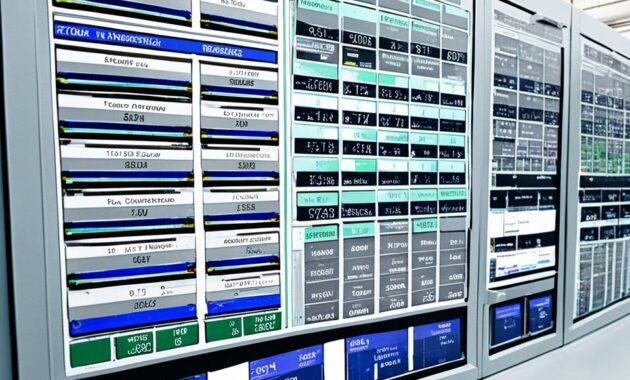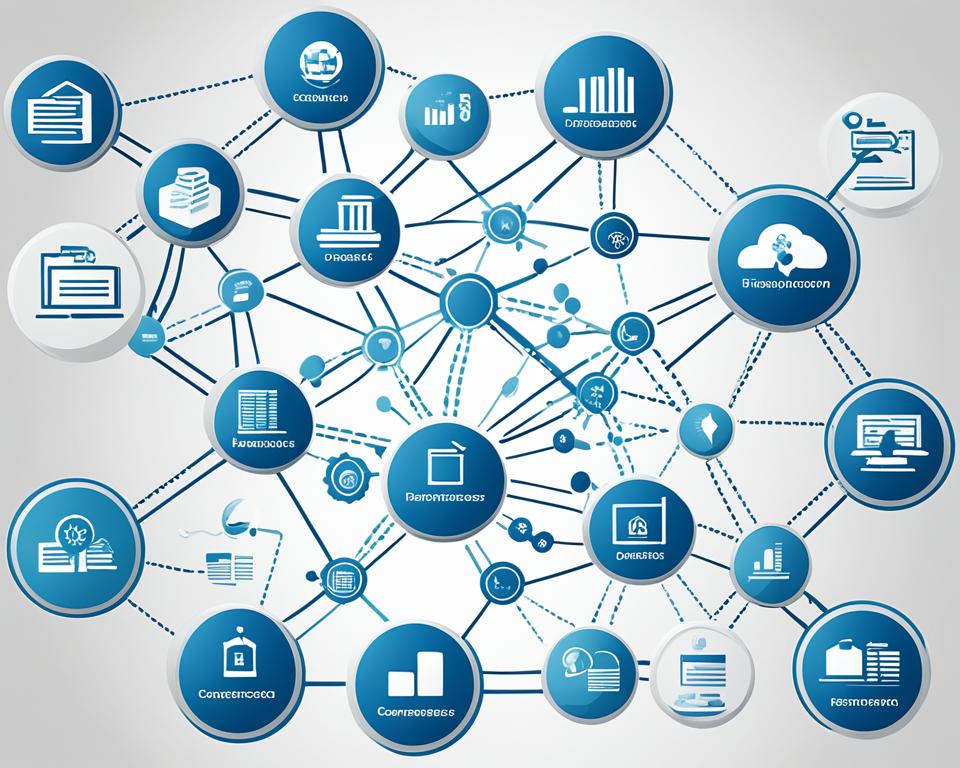In today’s fast-paced business landscape, organizations face the challenge of managing an ever-growing array of operations and data. Enterprise resource management (ERM) emerges as a comprehensive solution that integrates and streamlines various business functions, from supply chain management to financial planning and human resources. By implementing an ERM system, organizations can optimize their operations, boost efficiency, and drive growth.
This article will explore the key aspects of enterprise resource management, its features, and the benefits of adopting an ERM system. Whether you’re a small business owner or the leader of a large enterprise, understanding the power of ERM can help you unlock new levels of productivity, profitability, and success.
Key Takeaways
- Enterprise resource management (ERM) is a comprehensive solution that integrates and streamlines various business functions.
- ERM systems can help organizations optimize operations, boost efficiency, and drive growth.
- This article will explore the key features and benefits of adopting an ERM system.
- ERM can benefit businesses of all sizes, from small enterprises to large corporations.
- Understanding the power of ERM can unlock new levels of productivity and profitability for your organization.
What is Enterprise Resource Management (ERP)?
Enterprise resource management (ERP) is a comprehensive software solution that integrates and streamlines various business processes within an organization. It serves as a centralized platform for managing critical functions such as inventory control, financial planning, supply chain management, and human resources.
Integrated Business Management Software
ERP systems bring together disparate business operations into a single, unified system. This integrated management software enables organizations to access real-time information, automate workflows, and make more informed decisions. By consolidating data from across the enterprise, ERP solutions provide a holistic view of the business, improving efficiency and productivity.
Centralized Data for Better Decision-Making
The centralized data generated by ERP systems is a powerful asset, allowing for enhanced data analytics and business intelligence. Organizations can leverage this centralized information to identify trends, optimize processes, and gain a competitive edge in the market. ERP’s data-driven insights empower businesses to make more informed, strategic decisions that drive growth and profitability.
Key Features of Enterprise Resource Management
Effective ERP systems typically include a range of essential features that help organizations manage and optimize their operations. These features are designed to streamline business process automation, enhance supply chain management, improve inventory control, enable better financial planning, and support human resources management.
One of the key features of enterprise resource management is supply chain management. ERP systems help organizations streamline the procurement, production, and distribution of goods and services, ensuring efficient and responsive supply chain operations.
Inventory control is another critical component of ERP systems. These systems provide real-time visibility into inventory levels, enabling organizations to track and manage their stock effectively, minimizing the risk of stockouts or overstocking.
ERP systems also integrate financial planning and accounting functionalities, allowing businesses to centralize financial data and automate accounting processes. This helps improve financial management, reporting, and decision-making.
Additionally, ERP systems often include human resources management features, such as employee information management, payroll processing, and HR task automation. This allows organizations to streamline their HR processes and better manage their workforce.
Finally, many ERP systems incorporate business intelligence and data analytics capabilities, providing real-time insights and enabling data-driven decision-making. These features help organizations optimize their operations, identify areas for improvement, and better align their strategies with their overall business goals.
| ERP Feature | Description |
|---|---|
| Supply Chain Management | Streamlining the procurement, production, and distribution of goods and services |
| Inventory Control | Tracking and managing inventory levels to ensure efficient stock management |
| Financial Planning and Accounting | Integrating financial data and automating accounting processes |
| Human Resources Management | Centralizing employee information and automating HR tasks |
| Business Intelligence and Data Analytics | Providing real-time insights and data-driven decision-making |

Benefits of Implementing an Enterprise Resource Management System
Adopting an enterprise resource management (ERP) system can unlock a wealth of benefits for organizations across various industries. ERP software streamlines business processes, enhances operational efficiency, and provides comprehensive data analytics to drive informed decision-making.
Increased Operational Efficiency
One of the primary advantages of implementing an ERP system is the ability to automate and streamline business processes. ERP platforms integrate disparate systems and eliminate manual tasks, freeing up employees to focus on more strategic initiatives. By automating workflows, organizations can improve productivity, reduce errors, and enhance overall operational efficiency.
Improved Inventory Control and Supply Chain Management
ERP systems offer robust inventory management and supply chain capabilities, providing a centralized platform to oversee and optimize these critical business functions. With real-time data on inventory levels, purchasing, and distribution, organizations can make more informed decisions, improve forecasting, and enhance supply chain coordination. This, in turn, leads to reduced inventory costs, increased customer satisfaction, and better supply chain resilience.
| Key Benefit | Description |
|---|---|
| Operational Efficiency | ERP systems automate and streamline business processes, reducing manual tasks and improving workflow. |
| Inventory Control | ERP software integrates inventory data, enabling better forecasting, procurement, and distribution planning. |
| Supply Chain Management | ERP platforms provide a centralized view of supply chain information, enhancing coordination and visibility. |
| Data-Driven Decision-Making | ERP systems offer comprehensive data analytics and business intelligence capabilities, empowering organizations to make more informed strategic decisions. |
By leveraging the capabilities of an ERP system, organizations can drive increased operational efficiency, enhance inventory control, and streamline supply chain management, ultimately positioning themselves for long-term success in a competitive business landscape.
Conclusion
Enterprise resource management (ERM) is a powerful tool that can help organizations streamline their operations, boost efficiency, and drive growth. By integrating various business functions into a centralized platform, ERP systems provide real-time data, automate workflows, and enable data-driven decision-making. Implementing an effective ERM solution can lead to improved inventory control, enhanced supply chain management, and increased overall operational efficiency.
As businesses strive to stay competitive in today’s dynamic market, adopting an enterprise resource management system can be a strategic investment that pays dividends in the long run. With the ability to optimize business processes and leverage data-driven insights, ERP systems empower organizations to make informed decisions and adapt to changing market conditions with greater agility.
By embracing the power of enterprise resource management, businesses can streamline their operations, enhance their competitiveness, and position themselves for sustained growth and success in the years ahead.

